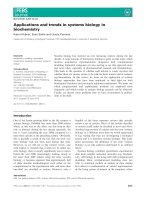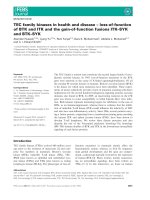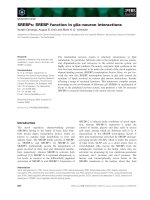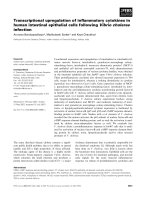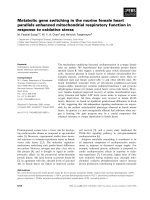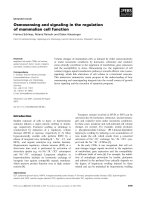Tài liệu Báo cáo khoa học: "Insights into Non-projectivity in Hindi" docx
Bạn đang xem bản rút gọn của tài liệu. Xem và tải ngay bản đầy đủ của tài liệu tại đây (175.17 KB, 8 trang )
Proceedings of the ACL-IJCNLP 2009 Student Research Workshop, pages 10–17,
Suntec, Singapore, 4 August 2009.
c
2009 ACL and AFNLP
Insights into Non-projectivity in Hindi
Prashanth Mannem, Himani Chaudhry, Akshar Bharati
Language Technologies Research Center,
International Institute of Information Technology,
Gachibowli, Hyderabad, India - 500032
{prashanth,himani}@research.iiit.ac.in
Abstract
Large scale efforts are underway to cre-
ate dependency treebanks and parsers
for Hindi and other Indian languages.
Hindi, being a morphologically rich, flex-
ible word order language, brings chal-
lenges such as handling non-projectivity
in parsing. In this work, we look
at non-projectivity in Hyderabad De-
pendency Treebank (HyDT) for Hindi.
Non-projectivity has been analysed from
two perspectives: graph properties that
restrict non-projectivity and linguistic
phenomenon behind non-projectivity in
HyDT. Since Hindi has ample instances
of non-projectivity (14% of all structures
in HyDT are non-projective), it presents
a case for an in depth study of this phe-
nomenon for a better insight, from both of
these perspectives.
We have looked at graph constriants like
planarity, gap degree, edge degree and
well-nestedness on structures in HyDT.
We also analyse non-projectivity in Hindi
in terms of various linguistic parameters
such as the causes of non-projectivity,
its rigidity (possibility of reordering) and
whether the reordered construction is the
natural one.
1 Introduction
Non-projectivity occurs when dependents do not
either immediately follow or precede their heads
in a sentence (Tesnire, 1959). These dependents
may be spread out over a discontinuous region of
the sentence. It is well known that this poses prob-
lems for both theoretical grammar formalisms as
well as parsing systems. (Kuhlmann and M
¨
ohl,
2007; McDonald and Nivre, 2007; Nivre et al.,
2007)
Hindi is a verb final, flexible word order lan-
guage and therefore, has frequent occurrences
of non-projectivity in its dependency structures.
Bharati et al. (2008a) showed that a major chunk
of errors in their parser is due to non-projectivity.
So, there is a need to analyse non-projectivity in
Hindi for a better insight into such constructions.
We would like to say here, that as far as we are
aware, there hasn’t been any attempt to study non-
projectivity in Hindi before this work. Our work
is a step forward in this direction.
Non-projectivity can be analysed from two as-
pects. a) In terms of graph properties which re-
strict non-projectivity and b) in terms of linguis-
tic phenomenon giving rise to non-projectivity.
While a) gives an idea of the kind of grammar for-
malisms and parsing algorithms required to handle
non-projective cases in a language, b) gives an in-
sight into the linguistic cues necessary to identify
non-projective sentences in a language.
Parsing systems can explore algorithms and
make approximations based on the coverage of
these graph properties on the treebank and lin-
guistic cues can be used as features to restrict the
generation of non-projective constructions (Shen
and Joshi, 2008). Similarly, the analyses based on
these aspects can also be used to come up with
broad coverage grammar formalisms for the lan-
guage.
Graph constraints such as projectivity, pla-
narity, gap degree, edge degree and well-
nestedness have been used in previous works to
look at non-projective constructions in treebanks
like PDT and DDT (Kuhlmann and Nivre, 2006;
Nivre, 2006). We employ these constraints in our
work too. Apart from these graph constraints, we
also look at non-projective constructions in terms
of various parameters like factors leading to non-
projectivity, its rigidity (see Section 4), its approx-
imate projective construction and whether its the
natural one.
10
In this paper, we analyse dependency structures
in Hyderabad Dependency Treebank (HyDT).
HyDT is a pilot treebank containing dependency
annotations for 1865 Hindi sentences. It uses
the annotation scheme proposed by Begum et al.
(2008), based on the Paninian grammar formal-
ism.
This paper is organised as follows: In section
2, we give an overview of HyDT and the annota-
tion scheme used. Section 3 discusses the graph
properties that are used in our analysis and section
4 reports the experimental results on the coverage
of these properties on HyDT. The linguistic anal-
ysis of non-projective constructions is discussed
case by case in Section 5. The conclusions of this
work are presented in section 6. Section 7 gives
directions for future works on non-projectivity for
Hindi.
2 Hyderabad Dependency Treebank
(HyDT)
HyDT is a dependency annotated treebank for
Hindi. The annotation scheme used for HyDT is
based on the Paninian framework (Begum et al.,
2008). The dependency relations in the treebank
are syntactico-semantic in nature where the main
verb is the central binding element of the sentence.
The arguments including the adjuncts are anno-
tated taking the meaning of the verb into consid-
eration. The participants in an action are labeled
with karaka relations (Bharati et al., 1995). Syn-
tactic cues like case-endings and markers such as
post-positions and verbal inflections, help in iden-
tifying appropriate karakas.
The dependency tagset in the annotation
scheme has 28 relations in it. These include
six basic karaka relations (adhikarana [location],
apaadaan [source], sampradaan [recipient], karana
[instrument], karma [theme] and karta [agent] ).
The rest of the labels are non-karaka labels like
vmod, adv, nmod, rbmod, jjmod etc
1
The
tagset also includes special labels like pof and
ccof, which are not dependency relations in the
strict sense. They are used to handle special
constructions like conjunct verbs (ex:- prashna
kiyaa (question did)), coordinating conjunc-
tions and ellipses.
In the annotation scheme used for HyDT, re-
lations are marked between chunks instead of
1
The entire dependency tagset can be found at
/>words. A chunk (with boundaries marked) in
HyDT, by definition, represents a set of adjacent
words which are in dependency relation with each
other, and are connected to the rest of the words
by a single incoming dependency arc. The rela-
tions among the words in a chunk are not marked.
Thus, in a dependency tree in HyDT, each node is
a chunk and the edge represents the relations be-
tween the connected nodes labeled with the karaka
or other relations. All the modifier-modified rela-
tions between the heads of the chunks (inter-chunk
relations) are marked in this manner. The annota-
tion is done using Sanchay
2
mark up tool in Shakti
Standard Format (SSF) (Bharati et al., 2005). For
the work in this paper, to get the complete depen-
dency tree, we used an automatic rule based intra-
chunk relation identifier. The rules mark these
intra-chunk relations with an accuracy of 99.5%,
when evaluated on a test set.
The treebank has 1865 sentences with a total of
16620 chunks and 35787 words. Among these,
14% of the sentences have non-projective struc-
tures and 1.87% of the inter-chunk relations are
non-projective. This figure drops to 0.87% if we
consider the intra-chunk relations too (as all intra-
chunk relations are projective). In comparison,
treebanks of other flexible word order languages
like Czech and Danish have non-projectivity in
23% (out of 73088 sentences) and 15% (out
of 4393 sentences) respectively (Kuhlmann and
Nivre, 2006; Nivre et al., 2007).
3 Non projectivity and graph properties
In this section, we define dependency graph for-
mally and discuss standard propertiess uch as sin-
gle headedness, acyclicity and projectivity. We
then look at complex graph constraints like gap de-
gree, edge degree, planarity and well-nestedness
which can be used to restrict non-projectivity in
graphs.
In what follows, a dependency graph for an in-
put sequence of words x
1
· · · x
n
is an unlabeled
directed graph D = (X, Y ) where X is a set of
nodes and Y is a set of directed edges on these
nodes. x
i
→ x
j
denotes an edge from x
i
to x
j
,
(x
i
, x
j
) ∈ Y . →
∗
is used to denote the reflexive
and transitive closure of the relation. x
i
→
∗
x
j
means that the node x
i
dominates the node x
j
,
i.e., there is a (possibly empty) path from x
i
to
x
j
. x
i
↔ x
j
denotes an edge from x
i
to x
j
or vice
2
/>11
versa. For a given node x
i
, the set of nodes domi-
nated by x
i
is the projection of x
i
. We use π(x
i
) to
refer to the projection of x
i
arranged in ascending
order.
Every dependency graph satisfies two con-
straints: acyclicity and single head. Acyclicity
refers to there being no cycles in the graph. Sin-
gle head refers to each node in the graph D having
exactly one incoming edge (except the one which
is at the root). While acyclicity and single head
constraints are satisfied by dependency graphs in
almost all dependency theories. Projectivity is a
stricter constraint used and helps in reducing pars-
ing complexities.
Projectivity: If node x
k
depends on node x
i
,
then all nodes between x
i
and x
k
are also subordi-
nate to x
i
(i.e dominated by x
i
) (Nivre, 2006).
x
i
→ x
k
⇒ x
i
→
∗
x
j
∀x
j
∈ X : (x
i
< x
j
< x
k
∨ x
i
> x
j
> x
k
)
Any graph which doesn’t satisfy this constraint
is non-projective. Unlike acyclicity and the sin-
gle head constraints, which impose restrictions
on the dependency relation as such, projectivity
constrains the interaction between the dependency
relations and the order of the nodes in the sen-
tence (Kuhlmann and Nivre, 2006)
Graph properties like planarity, gap degree,
edge degree and well-nestedness have been pro-
posed in the literature to constrain grammar for-
malisms and parsing algorithms from looking at
unrestricted non-projectivity. We define these
properties formally here.
Planarity: A dependency graph is planar if
edges do not cross when drawn above the sentence
(Sleator and Temperley, 1993). It is similar to pro-
jectivity except that the arc from dummy node at
the beginning (or the end) to the root node is not
considered.
∀(x
i
, x
j
, x
k
, x
l
) ∈ X,
¬((x
i
↔ x
k
∧ x
j
↔ x
l
) ∧ (x
i
< x
j
< x
k
< x
l
))
Gap degree: The gap degree of a node is the
number of gaps in the projection of a node. A gap
is a pair of nodes (π(x
i
)
k
, π(x
i
)
k+1
) adjacent in
π(x
i
) but not adjacent in sentence. The gap de-
gree of node Gd(x
i
) is the number of such gaps
in its projection. The gap degree of a sentence
is the maximum among gap degrees of nodes in
D(X, Y ) (Kuhlmann, 2007).
Edge degree: The number of connected com-
ponents in the span of an edge which are not
dominated by the outgoing node in the edge.
Span span(x
i
→ x
j
) = (min(i, j), max(i, j)).
Ed(x
i
→ x
j
) is the number of connected com-
ponenets in the span span(x
i
→ x
j
) whose parent
is not in the projection of x
i
. The edge degree of
a sentence is the maximum among edge degrees
of edges in D(X, Y ). (Nivre, 2006) defines it as
degree of non-projectivity. Following (Kuhlmann
and Nivre, 2006), we call this edge degree to avoid
confusion.
Well-nested: A dependency graph is well-
nested if no two disjoint subgraphs interleave
(Bodirsky et al., 2005). Two subgraphs are dis-
joint if neither of their roots dominates the other.
Two subtrees S
i
,S
j
interleave if there are nodes
x
l
, x
m
∈ S
i
and x
n
, x
o
∈ S
j
such that l < m <
n < o (Kuhlmann and Nivre, 2006).
The gap degree and the edge degree provide
a quantitative measure for the non-projectivity of
dependency structures. Well-nestedness is a qual-
itative property: it constrains the relative positions
of disjoint subtrees.
4 Experiments on HyDT
Property Count Percentage
All structures 1865
Gap degree
Gd(0) 1603 85.9%
Gd(1) 259 13.89%
Gd(2) 0 0%
Gd(3)
3 0.0016%
Edge degree
Ed(0) 1603 85.9%
Ed(1) 254 13.6%
Ed(2) 6 0.0032%
Ed(3) 1 0.0005%
Ed(4) 1 0.0005%
Projective 1603 85.9%
Planar 1639 87.9%
Non-projective 36 1.93%
& planar
Well-nested 1865 100%
Table 1: Results on HyDT
In this section, we present an experimental eval-
uation of the graph constraints mentioned in the
previous section on the dependency structures in
12
_ROOT_ tab raat lagabhag chauthaaii Dhal__chukii__thii jab unheM behoshii__sii aaiii
then night about one−fourth over be.PastPerf. when him unconsciouness PART. came
About one−fourth of the night was over when he started becoming unconscious
_ROOT_ hamaaraa maargadarshak__aur__saathii saty__hai , jo iishvar__hai
Truth, which is God, is our guide and companion
our guide and companion truth is , which God is
a)
b)
Figure 1: a) Relative co-relative construction, b) Extraposed relative clause construction
HyDT. Since HyDT is a small corpus and is still
under construction, these results might not be the
exact reflection of naturally occurring sentences in
real-world. Nevertheless, we hope these results
will give an idea of the kind of structures one can
expect in Hindi.
We report the percentage of structures that
satisfy various graph properties in table 1. In
HyDT, we see that 14% of all structures are non-
projective. The highest gap degree for structures
in HyDT is 3 and in case of edge degree, it is 4.
Only 3 structures (1.5% approx.) have gap de-
gree of more than 1 in a total of 262 non-projective
sentences. When it comes to edge degree, only 8
structures (3%) have edge degree more than 1.
The difference in the coverage of gap degree
1 & 2 (and the fact that gap degree 1 accounts
for 13.9% of the structures) shows that a parser
should handle non-projective constructions at least
till gap degree 1 for good coverage. The same can
be said about edge degree.
5 Cases of non-projectivity in HyDT
We have carried out a study of the instances of
non-projectivity that HyDT brought forth. In
this section, we classify these instances based on
factors leading to non-projectivity and present
our analysis of them. For each of these classes,
we look at the rigidity of these non-projective
constructions and their best projective approxi-
mation possible by reordering. Rigidity here is
the reorderability of the constructions retaining
the gross meaning. Gross meaning refers to the
meaning of the sentence not taking the discourse
and topic-focus into consideration, which is how
parsing is typically done.
e.g., the non-projective construction in figure 1b,
yadi rupayoM kii zaruurat thii to
mujh ko bataanaa chaahiye thaa
3
can be reordered to form a projective construction
mujh ko bataanaa chaahiye thaa
yadi rupayoM kii zaruurat thii
to. Therefore, this sentence is not rigid.
Study of rigidity is important from natural lan-
guage generation perspective. Sentence genera-
tion from projective structures is easier and more
efficient than from non-projective ones. Non-
projectivity in constructions that are non-rigid can
be effectively dealt with through projectivisation.
Further, we see if these approximations are
more natural compared to the non-projective ones
as this impacts sentence generation quality. A nat-
ural construction is the one most preferred by na-
tive speakers of that language. Also, it more or less
abides by the well established rules and patterns of
the language.
We observed that non-projectivity is caused in
Hindi, due to various linguistic phenomena mani-
fested in the language, such as relative co-relative
constructions, paired connectives, complex co-
ordinating structures, interventions in verbal argu-
ments by non-verbal modifiers, shared arguments
in non-finite clauses, movement of modifiers, el-
lipsis etc. Also, non-projectivity in Hindi can oc-
cur within a clause (intra-clausal) as well as be-
tween elements across clauses (inter-clausal).
We now discuss some of these linguistic phe-
nomena causing non-projectivity.
3
The glosses for the sentences in this section are listed in
the corresponding figures and are not repeated to save space.
13
Gorki if this new literature of creator was then socialism its solid base was
If Gorki was the creator of this new literature, then socialism was its solid base
b)
_ROOT_ gorkii yadi is__naye__saahity__ke__srishtikartaa the to samaajavaad isakaa Thos aadhaar thaa
a)
_ROOT_ yadi rupayoM kii zaruurat thii to mujh ko bataanaa__chahiye__thaa
if rupees of need was then me Dat. told should be(past)
If [you] needed rupees then [you] should have told me
Figure 2: a) Paired connectives construction, b) Construction with non-projectivity within a clause
5.1 Relative co-relative constructions
The pattern in co-relatives is that a demonstra-
tive pronoun, which also functions as deter-
miner in Hindi, such as vo (that), always oc-
curs in correlation with a relative pronoun, jo
(which). In fact, the language employs a se-
ries of such pronouns : e.g., jis-us ‘which-
that’, jahaaM-vahaaM ‘where-there’, jidhar-
udhar ‘where-there’, jab-tab ‘when-then’,
aise-jaise (Butt et al., 2007).
Non-projectivity is seen to occur in relative co-
relative constructions with pairs such as jab-tab,
if the clause beginning with the tab precedes the
jab clause as seen in figure 1a. If the clause with
the relative pronoun comes before the clause with
the demonstrative pronoun, non-projectivity can
be ruled out. So, this class of non-projective con-
structions is not rigid since projective structures
can be obtained by reordering without any loss of
meaning. The projective case is relatively more
natural than the non-projective one. This is reaf-
firmed in the corpus where the projective relative
co-relative structures are more frequent than the
non-projective sentences.
In the example in figure 1a, the sentence can be
reordered by moving the tab clause to the right
of the jab clause, to remove non-projectivity.
jab unheM behoshii sii aaii tab
raat lagabhag chauthaaii Dhal
chukii thii − when he started becoming
unconscious, about one-fourth of the night was
over
5.2 Extraposed relative clause constructions
If the relative clause modifying a noun phrase
(NP) occurs after the verb group (VP), it leads to
non-projectivity.
In the sentence in figure 1b, non-projectivity
occurs because jo iishvar hai, the rel-
ative clause modifying the NP hamaaraa
maargadarshak aur saathii is extra-
posed after the VP saty hai.
This class of constructions is not rigid as the
extraposed relative clause can be moved next to
the noun phrase, making it projective. However,
the resulting projective construction is less natural
than the original non-projective one.
The reordered projective construction
for the example sentence is hamaaraa
maargadarshak aur saathii, jo
iishvar hai, saty hai − Our guide and
companion which is God is truth
This class of non-projective constructions ac-
counts for approximately half of the total non-
projective sentences in the treebank.
5.3 Intra-clausal non-projectivity
In this case, the modifier of the NP is a non-relative
clause and is different from the class 5.2.
In the example in figure 2b, the NP
gorkii and the phrase modifying it is
naye saahity ke srishtikartaa are
separated by yadi, a modifier of to clause.
Intra-clausal non-projectivity here is within the
clause gorkii yadi is naye saahity
ke srishtikartaa the.
14
He had such [a] liking for sniff that he was not able to give it up
a)
_ROOT_ naas kaa unheM aisaa shauk_thaa ki usako tyaag na paate__the
sniff of him such liking was that it give−up not able−to was
_ROOT_ usakaa is__hiire__ke__liye lagaava svata: siddh__hai
his this diamond for love by−itself evident is
his love for this diamond is evident by itself
b)
Figure 3: a) ki complement clause, b) Genetive relation split by a verb modifier
To remove non-projectivity, reordering of such
sentences is possible by moving the non-modifier,
so that it no more separates them. Here, moving
yadi to the left of gorkii takes care of non-
projectivity thus making this class not rigid. The
reordered projective construction is more natural.
yadi gorkii is naye saahity ke
srishtikartaa the to samaajavaad
isakaa Thos aadhaar thaa
5.4 Paired connectives
Paired connectives (such as agar-to ’if -then’,
yadi-to ’if -then’) give rise to non-projectivity in
HyDT on account of the annotation scheme used.
As shown in figure 2a, the to clause is modified
by the yadi clause in such constructions. Most of
these sentences can be reordered while still retain-
ing the meaning of the sentence: the phrase that
comes after to, followed by yadi clause, and
then to. Here mentioning to is optional.
This sentence can be reordered and is not rigid.
However, the resulting projective construction
is not a natural one. mujh ko bataanaa
chaahiye thaa yadi rupayoM kii
zaruurat thii [to] − (you) should have
told me if (you) needed rupees
Connectives like yadi can also give rise to
intra-clausal non-projectivity apart from inter-
clausal non-projectivity as discussed. This hap-
pens when the connective moves away from the
beginning of the sentence (see figure 2b).
5.5 ki complement clause
A phrase (including a VP in it) appears between
the ki (that) clause and the word it modifies
(such as yaha (this), asiaa (such), is tarah
(such), itana (this much) ), resulting in non-
projectivity in the ki complement constructions.
The verb in this verb group is generally copular.
Since Hindi is a verb final language, the comple-
mentiser clause (ki clause) occurs after the verb
of the main clause, while its referent lies before
the verb in the main clause. This leads to non-
projectivity in such constructions. The yaha-ki
constructions follow the pattern: yaha-its prop-
erty-VP-ki clause.
E.g. yaha-rahasya-hai-ki shukl
jii pratham shreNii ke kavi kyoM
the.
This class of constructions are rigid and non-
projectivity can’t be removed from such sen-
tences. In cases where the VP has a transitive
verb, the ki clause and its referent, both mod-
ify the verb, making the construction projective.
For ex. In usane yaha kahaa ki vaha
nahin aayegaa, yaha and the ki clause both
modify the verb kahaa.
In figure 3a, the phrase shauk thaa sepa-
rates aisaa and the ki clause, resulting in non-
projectivity.
5.6 A genetive relation split by a verb
modifier
This is also a case of intra-clausal non-projectivity.
In such constructions, the verb has its modifier em-
bedded within the genetive construction.
In the example in figure 3b, the components of
the genetive relation, usakaa and lagaav are
separated by the phrase is hiire ke liye.
15
that writers’ identity Acc we proudly publisher before put.non−fin talk do be.Past
The writers’ identity that we proudly put before the publisher and talked [to him]
_ROOT_ us__lekhakiiy__asmitaa__ko ham sagarv prakaashak__ke−saamane rakhakar baat__karate__the
b)
a)
_ROOT_ isake__baad vah jamaan__shaah aur−phir 1795__meM shaah__shujaa ko milaa
this after it Jaman Shah and−then 1795 in Shah Shuja to got
After this Jaman Shah [got it] and then, in 1795 Shah Shuja got it
Figure 4: a) A phrase splitting a co-ordinating structure, b) Shared argument splitting the non finite
clause
The sentence is not rigid and can be reordered to
a projective construction by moving the phrase is
hiire ke liye to the left of usakaa. It re-
tains the meaning of the original construction and
is also, a more natural one.
is hiire ke liye usakaa lagaav
svata: siddh hai − his love for this
diamond is evident by itself
5.7 A phrase splitting a co-ordinating
structure
As seen in figure 4a, non-projectivity is caused
in the sentence because, embedding of the
phrase 1795 meM splits the co-ordinating
structure jamaan shaah aur-phir shaah
shujaa. These kinds of constructions can be re-
ordered. So, they are not rigid. The projective
constructions are more natural.
isake baad vah jamaan shaah ko
aur-phir shaah shujaa ko 1795 meM
milaa
Non-projective Class Count %
Relative co-relatives constructions 18 6.8 %
Extraposed realtive clause constructions 101 38.0 %
Intra-clausal non-projectivity 12 4.5 %
Paired connectives 33 12.4 %
ki complement clauses 52 19.5 %
Genetive relation split by a verb modifier 10 3.8 %
Phrase splitting a co-ordinating structure
4 1.5 %
Shared argument splits the non-finite clause 10 3.8 %
Others 26 9.8 %
Table 2: Non-projectivity class distribution in HyDT
5.8 Shared argument splits the non finite
clause
In the example in 4b, hama is annotated as the ar-
gument of the main verb baawa karate the.
It also is the shared argument of the non finite
verb rakhakara (but isn’t marked explicitly in
the treebank). It splits the non finite clause us
lekhakiiya asmitaa ko ham sagarv
prakaashak ke saamane rakhakara
Through reordering, this sentence can easily be
made into a projective construction, which is also
the more natural construction for it.
ham us lekhakiiy asmitaa ko
sagarv prakaashak ke-saamane
rakhakar baat karate the
5.9 Others
There are a few non-projective constructions in
HyDT which haven’t been classified and discussed
in the eight categories above. This is because they
are single occurences in HyDT and seem to be rare
phenomenon. There are also a few instances of in-
consistent NULL placement and errors in chunk
boundary marking or annotation.
6 Conclusion
Our study of HyDT shows that non-projectivity in
Hindi is more or less confined to the classes dis-
cussed in this paper. There might be more types of
non-projective structures in Hindi which may not
have occurred in the treebank.
Recent experiments on Hindi dependency pars-
ing have shown that non-projective structures form
a major chunk of parsing errors (Bharati et al.,
16
2008a). In spite of using state-of-art parsers which
handle non-projectivity, experiments show that the
types of non-projectivity discussed in this paper
are not handled effectively.
The knowledge of such non-projective classes
could possibly be used to enhance the perfor-
mance of a parser. This work further corrobo-
rates Kuhlmann’s work on Czech (PDT) for Hindi
(Kuhlmann and Nivre, 2006). Specifically, as dis-
cussed in section 4, the non-projective structures
in HyDT satisfy the constraints (gap degree ≤ 2
and well-nestedness) to be called as mildly non-
projective.
7 Future Work
We propose to use the analysis in this paper to
come up with non-projective parsers for Hindi.
This can be done in more than one ways, such as:
The constraint based dependency parser for
Hindi proposed in (Bharati et al., 2008b) can be
extended to incorporate graph properties discussed
in section 3 as constraints.
Further, linguistic insights into non-projectivity
can be used in parsing to identify when to generate
the non-projective arcs. The parser can have spe-
cialised machinery to handle non-projectivity only
when linguistic cues belonging to these classes are
active. The advantage of this is that one need not
come up with formal complex parsing algorithms
which give unrestricted non-projective structures.
As the HyDT grows, we are bound to come
across more instances as well as more types of
non-projective constructions that could bring forth
interesting phenomenon. We propose to look into
these for further insights.
References
R. Begum, S. Husain, A. Dhwaj, D. Sharma, L. Bai, and
R. Sangal. 2008. Dependency annotation scheme for in-
dian languages. In In Proceedings of The Third Interna-
tional Joint Conference on Natural Language Processing
(IJCNLP), Hyderabad, India.
Akshar Bharati, Vineet Chaitanya, and Rajeev Sangal. 1995.
Natural Language Processing: A Paninian Perspective.
Prentice-Hall of India.
Akshar Bharati, Rajeev Sangal, and Dipti Sharma. 2005.
Shakti analyser: Ssf representation. Technical report, In-
ternational Institute of Information Technology, Hyder-
abad, India.
Akshar Bharati, Samar Husain, Bharat Ambati, Sambhav
Jain, Dipti Sharma, and Rajeev Sangal. 2008a. Two se-
mantic features make all the difference in parsing accu-
racy. In Proceedings of the 6th International Conference
on Natural Language Processing (ICON-08), Pune, India.
Akshar Bharati, Samar Husain, Dipti Sharma, and Rajeev
Sangal. 2008b. A two-stage constraint based dependency
parser for free word order languages. In Proceedings of
the COLIPS International Conference on Asian Language
Processing 2008 (IALP), Chiang Mai, Thailand.
Manuel Bodirsky, Marco Kuhlmann, and Mathias Mhl. 2005.
Well-nested drawings as models of syntactic structure. In
In Tenth Conference on Formal Grammar and Ninth Meet-
ing on Mathematics of Language, pages 88–1. University
Press.
M. Butt, T. H. King, and S. Roth. 2007. Urdu correlatives:
Theoretical and implementational issues. In Online Pro-
ceedings of the LFG07 Conference, pages 87–106. CSLI
Publications.
Marco Kuhlmann and Mathias M
¨
ohl. 2007. Mildly context-
sensitive dependency languages. In Proceedings of the
45th Annual Meeting of the Association of Computa-
tional Linguistics, pages 160–167, Prague, Czech Repub-
lic, June. Association for Computational Linguistics.
Marco Kuhlmann and Joakim Nivre. 2006. Mildly non-
projective dependency structures. In Proceedings of the
COLING/ACL 2006 Main Conference Poster Sessions,
pages 507–514, Sydney, Australia, July. Association for
Computational Linguistics.
Marco Kuhlmann. 2007. Dependency Structures and Lexi-
calized Grammars. Ph.D. thesis, Saarland University.
Ryan McDonald and Joakim Nivre. 2007. Characterizing
the errors of data-driven dependency parsing models. In
Proceedings of the 2007 Joint Conference on Empirical
Methods in Natural Language Processing and Compu-
tational Natural Language Learning (EMNLP-CoNLL),
pages 122–131, Prague, Czech Republic, June. Associa-
tion for Computational Linguistics.
Joakim Nivre, Johan Hall, Sandra K
¨
ubler, Ryan McDon-
ald, Jens Nilsson, Sebastian Riedel, and Deniz Yuret.
2007. The CoNLL 2007 shared task on dependency pars-
ing. In Proceedings of the CoNLL Shared Task Session of
EMNLP-CoNLL 2007, pages 915–932, Prague, Czech Re-
public, June. Association for Computational Linguistics.
Joakim Nivre. 2006. Constraints on non-projective depen-
dency parsing. In In Proceedings of European Association
of Computational Linguistics (EACL), pages 73–80.
Libin Shen and Aravind Joshi. 2008. LTAG dependency
parsing with bidirectional incremental construction. In
Proceedings of the 2008 Conference on Empirical Meth-
ods in Natural Language Processing, pages 495–504,
Honolulu, Hawaii, October. Association for Computa-
tional Linguistics.
Daniel Sleator and Davy Temperley. 1993. Parsing english
with a link grammar. In In Third International Workshop
on Parsing Technologies.
L. Tesnire. 1959. lments de Syntaxe Structurale. Libraire C.
Klincksieck, Paris.
17

